Make Way for Pollinators, March 2024
New Ordering Process for 2024
Happy March! With April just around the corner, we are excited to roll out our official catalogs and resources for the 2024 Program.
This year, we are doing things a bit differently. We’ve separated the catalog from the “shopping cart” to streamline the checkout process. For a quick and easy checkout, we’ve made printable planning sheets that you can use to mark which species and kits you would like. This way, on April 1st when the email is sent with the “shopping cart” order form link (it will also be posted on our website), you can go there directly and pick what you would like to order.
To save space, the “shopping cart” does not have information about each species, and instead you can use one of our two catalog pages. The first is on our website catalog. It has three navigable pages for the individual species, garden kits and additional items. We recommend using this website if you are browsing on your smartphone.
If you are browsing on a computer, we have a PDF catalog that we recommend using. The PDF catalog and the website catalog have the same information on the plants and garden kits; however, the PDF catalog has additional navigational links, companion plant recommendations, and an At-A-Glance section with an overview of the garden kits and individual species.
Once you have browsed the catalogs and decided what you would like, write it down! Use scrap paper or print our Garden Kits Planning Sheet and Individual Species Planning Sheet to record what you would like. Next, all you have to do is wait. On April 1st, after the kickoff webinar, we will send out the link to the shopping cart. There, you can add what species and kits you want, choose your pickup location, and place your order.
2024 Resources
Like the previous programs, we have an array of resources to help your decision process. Below are links to our downloadable PDF catalog, printer-friendly catalog, planning sheets, garden kits manuals and plant – pollinator interactions list.
Planning Resources: These links will help you in your decision process, all of which can be done BEFORE April 1st. We have the entire 36-page PDF catalog complete with photos, icons and descriptions for each plant and kit. Our Printer-Friendly Catalog is a 3-page table that saves your printer ink and paper by omitting the photos and descriptions for a table with each plant’s bloom information, height, deer resistance, and water and light requirements. Lastly, we have our planning sheets with the kit and species information along with a space for notes.
- Downloadable PDF Catalog
- Printer-Friendly Catalog
- Garden Kit Planning Sheet
- Individual Species Planning Sheet
Garden Kit Resources: New to gardening or looking to expand your knowledge? We have you covered! These manuals cover the A-Z on native gardening – from planting your plugs to garden maintenance once your garden is established. They also have sample planting designs, what to expect throughout the year, and some pollinators you may see frequenting your garden.
- Best-Behaved Kit Manual
- Deer Resistant Kit Manual
- Dry Shade Kit Manual
- Dry Sun Kit Manual
- Wet Shade Kit Manual
- Wet Sun Kit Manual
Pollinator Information: All the native plants included in our Native Plant Program provide critical habitat and food for pollinators, and supporting the highest diversity possible is important. We have compiled a list with some, but not all, of the pollinators that rely on these species. This does not include all of the wildlife that need native plants in their habitat, because the list would never end!
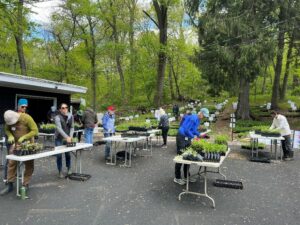

Calling All Volunteers! Factory Days Signups Now Open
We are now accepting volunteer sign-ups for our plant processing week! Click here to sign up and choose your time slot. We rely on our trusted volunteers and could not do this program without you!
Halfway through the Plant for Pollinator Webinars Series and Going Strong!
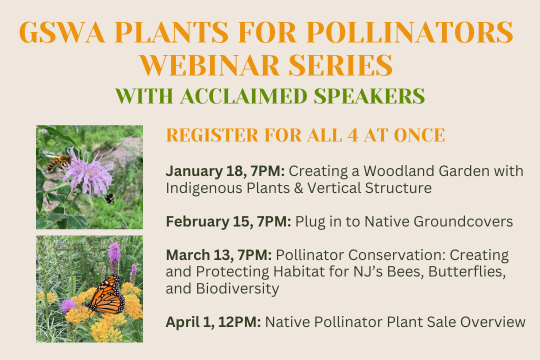

GSWA has already hosted two virtual talks with experts on how to garden with native plants. Jean Epiphan and John Mark Courtney shared their wisdom on Jan. 18 and Feb. 15 respectively. Access to recordings may be requested by emailing info@greatwamp.org with the video title in your request.
“Creating a Sustainable Woodland Garden Under Canopy Trees: Employing Diversity of Indigenous Plants & Vertical Structure While Improving Soil Health and Function”
Epiphan is an assistant professor with Rutgers Cooperative Extension in Morris County and serves as the Research Project Coordinator at the Rutgers Center for Urban Environmental Sustainability. Her presentation explored how to recreate and stabilize natural plant communities native to Central Appalachia.
Indigenous plants have evolved to live together and create biodiverse ecosystems. Gardeners can save money and effort by identifying and supporting what is already growing on their property. Many beneficial species that are not commercially available may already be growing on your property, all you have to do is pay attention.
When looking to add plants to your property, use free resources like conservationgateway.org to become familiar with your local climate and soil type. Plants differ in their preferred levels of moisture and sunlight, as well as the companion species they flourish alongside. To give new additions the best chance of success, let leaf litter build up as a natural form of fertilizer. If you cannot “leave the leaves,” Epiphan recommends applying mulch made from coniferous trees.
Gardeners should aim to promote natural forest succession by strengthening the understory. This contains the regenerative layers where saplings and the next successional species grow. In many forests these layers are barren due to high deer populations, but wire fencing can be used to protect saplings.
A woodland garden’s upkeep reaps far more benefits than a lawn’s. Pruning tall deciduous tall shrubs such as black elderberry and blackhaw viburnum in a v-shape creates more space for shorter shrubs and groundcover plants. Star sedge, one of Epiphan’s favorite sedge species, should be raked gently after they naturally “flop.” “Some people don’t like that because it’s maintenance, but every plant has maintenance,” Epiphan said. When these plants’ needs are met, they create a series of lush green layers that reduce soil erosion from rain.
“Plug Into Native Groundcovers”
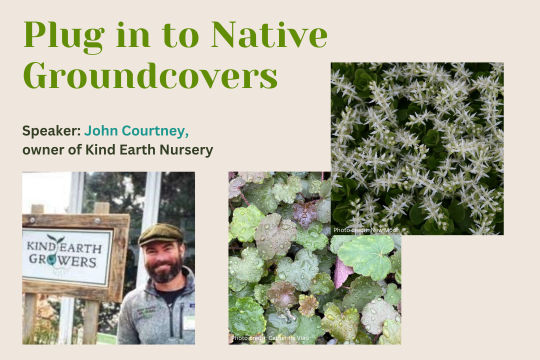

The ripple effects of a few landscaping decisions are astonishing. Courtney recounted how a change as simple as swapping a monoculture lawn for sedges can slash maintenance costs and reap a multitude of ecosystem services. The deep, fibrous root systems of sedges outcompete weeds, stabilize the soil, and improve stormwater infiltration. Additionally, Courtney admires the understated beauty of their blooms.
Getting started is as simple as leaving the leaves to naturally smother the grass. With the lawn out of the way, the land becomes your canvas.
Planting plugs instead of seeds is often the more economical, less labor-intensive option. For the best results, gardeners should identify the ideal planting season based on whether they are working with warm season or cool season species. Holes should not be deeper than the plugs, and excessive existing foliage should be cut back so the new plants are not immediately competing for sunlight.
Courtney advocated for gardeners to nurture what naturally appears, such as violets or wood poppies, instead of forcing a few rare plants to grow. Incorporating many species with different flowering times ensures the garden will always have something to offer pollinators and wildlife.
Building a diverse seedbank in the soil ensures something is always ready to sprout to fill a gap in the groundcover made by herbivory.
It also creates a shifting aesthetic. “This garden is always in flux, it’s always changing,” Courtney said. He encouraged attendees to take time to appreciate the “serendipitous moments” and the natural variation from season to season and year to year. Fostering diverse native groundcover ensures your garden will always have something new to offer each time you admire it.
Going Forward
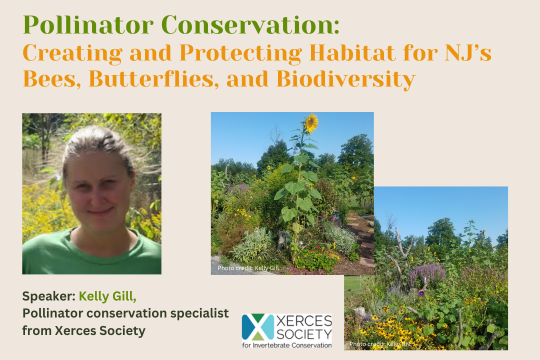

On March 13th at 7:00pm, Pollinator Conservation Specialist Kelly Gill of the Xerces Society will explain how to support declining insect populations. “Pollinator Conservation: Creating and Protecting Habitat for NJ’s Bees, Butterflies, and Biodiversity” will cover the benefits of native flowering plants, how to help pollinators survive the winter, and how to reduce the impacts of pesticides.
On April 1st at noon, our “Plants for Pollinators Plant Sale Overview” will dive into the unique characteristics of each species for sale. By the end of this talk, you will know exactly what you want based on your garden’s needs and which pollinators you hope to attract.
Take the Pledge to Not Plant Invasives
Please “Make The Pledge” to NOT plant any of the invasive species listed on the New Jersey Invasive Species Strike Team (NJISST) “Do Not Plant List” and to plant native species instead.
Make Your Pledge and sign up to receive GSWA Plant For Pollinators communications.
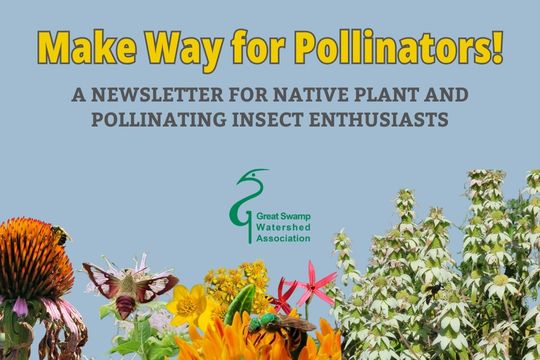
I have a portion of yard that is wet seasonally but dry in the summer. Would I buy the plant plugs for “wet sun kit /wet shade kit”?
Susanne
Susanne, just seeing this. Specific queries about plants or garden designs, should be emailed to: plantsale@greatswamp.org.